After Dinner Roast
 An after dinner roast, or after dinner blend, is intended to compliment after dinner desserts. A typical after dinner coffee is dark roasted and has low acidity.
|
Air Roaster
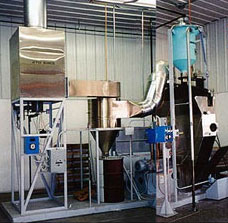 An air roaster, or fluid bed roaster, is a machine that uses fast streams of hot air to roast coffee beans. There are different types, or configurations, of air roasters, but all use hot air to convectively roast the beans and to help keep the beans moving. Most commercially available coffee is either air roasted or drum roasted.
|
American Roast
A light medium roast, the traditional roasting norm for North America. City (medium brown) to Full City (dark brown with oil drops) is the most common choice of specialty coffee consumers in America today, with a slightly darker roast preference in western United States. Also called "Brown Roast".
|
Artisan Coffee
Coffee produced by skilled Roasters using high quality Arabica coffee beans and modern roasting equipment. Fresh roasted premium whole bean coffee stands in contrast to ordinary, often harsh tasting, ground Robusta.
|
Batch Roaster
Batch roasters produce a fixed quantity (lbs per batch) of roasted beans at a time. In a batch roaster, the beans are removed before roasting the next batch. Continuous roasters produce roasted coffee at a fixed rate (lbs per hour).
|
Bean Probe
A probe thermometer used to monitor bean temperature during the roasting process. Bean probes accurately measure the surface temperature of coffee beans during roasting. Modern roasting systems use either resistance thermal detector (RTD), or thermocouple (TC), bean probes, along with electronic temperature controllers, to monitor and control the roasting process.
|
Bean Temperature
Roast degree is often defined by internal bean temperature, which cannot be measured directly, but can be approximated by the coffee bean surface temperature as measured by a bean probe (probe thermometer). Modern roasting systems monitor the surface temperature of roasting coffee beans, and can consistently recreate a roast by controlling the bean temperature vs. time profile. Final bean temperature, and time-temperature profiles, are now used in place of bean color monitoring for consistency in roasting. Internal bean temperatures are often cited along with bean probe temperatures when describing degree of roast, but actual internal bean temperature depends not only on the bean surface temperature, but also the time-temperature profile and type of roaster used.
|
Blend
 Coffee beans created by adding two or more varieties together. Coffees are blended before, and sometimes after, roasting. There are many reasons for blending coffee. Coffees may be blended to add balance, to create flavors not found in single origin coffees, to add body, to add crema, or to maintain flavor consistency as new crops present changes in flavor.
|
Chaff
 Chaff is the silver skin of the coffee bean released during roasting. While some coffees are put though an additional polishing step during processing to reduce the amount of attached silver skin, most unroasted coffee beans have a significant amount of the fine paper-like substance still attached which must be removed during roasting. As coffee beans are roasted, they expand to almost twice there original size. The dried out silver skin ruptures and is either burned away or carried away by the roast air. Most coffee roasters separate the chaff from the exhaust of their roasting machines using cyclone separators that collect the chaff in a metal bin.
|
Cinnamon Roast
A very light roast, producing coffee with a dry, and light colored, surface. Cinnamon roasted coffee is under-roasted for most peoples tastes, and typically has a weak grainy aroma and a sour taste. Peaberries are a popular choice among those who enjoy lightly roasted coffee.
|
City Roast
A light roast, also called American Roast. A City roast has a light brown color, is not oily, and has more acidity than medium or dark roasts. As coffees are roasted darker, the coffees original character distinctions are replaced by roasty flavors. A city roast will impart little, if any, roasty flavor and will retain the coffees unique flavor characteristics.
|
Coffee Future
Contract to buy coffee at a specified price for delivery at a specified future date. Coffee futures are used by roasters to secure an adequate supply of coffee until the next harvest and as insurance to "lock-in" reasonable prices.
|
Current Crop
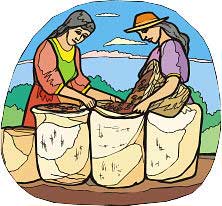 Current crop (CC), meaning coffee harvested during the current crop year. For example, a coffee harvested in October 2007 would be identified as 2007/2008 crop and would be current crop until October 2008. Coffee from a previous harvest year is referred to as old crop, or past crop.
|
Cyclone Separator
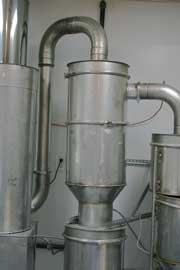 A cyclone separator is used to separate particulates, such as chaff, from roaster exhaust. The exhaust from cyclone separator is typically passed through a thermal oxidizer (incinerator) to burn the smoke. Roasters equipped with both a cyclone separator and thermal oxidizer emit a clean, smoke and particle free, exhaust.
|
Dark Roast
Coffee roasted to a dark brown to almost black color. Dark roasted coffee is typically more pungent and less acidy than medium or light roasted coffee. Maximum aroma and flavor, is generally found at the lighter end of the dark range. At the darkest end of the dark range, coffee has lost all of its acidity and has a distinctly burnt flavor.
|
Drum Roaster
 A drum roaster roasts coffee in batches and uses a drum to hold the roasting coffee. As the drum spins, hot gasses transfer heat to the drum and the drum conductively heats the tumbling coffee beans. Some drum roasters have perforated drums that allow hot gasses to pass through the drum and convectively heat the roasting coffee. Most commercially available coffee is either air roasted or drum roasted.
|
First Crack
The first of two distinctly different periods of cracking sounds during a roast, when the coffee beans are giving off their own heat and expanding suddenly. "first crack" begins at bean probe temperatures around 400 degrees Fahrenheit, making a sound similar to popcorn, and then diminishes, and sometimes stops momentarily, before the start of "second crack". "Second crack" begins at bean probe temperatures around 440 to 450 degrees Fahrenheit. The darkest of palatable roasts (Dark French) is attained at the peak of "second crack". If the roast is allowed to continue to completion of "second crack", the coffee will be burnt and may catch fire.
|
Flavored Coffee
Roasted coffee sprayed with flavoring. Flavored coffee is generally made using inexpensive, low quality, beans. The flavoring used is very strong and can transfer tastes and odors to other foods by contact with surfaces used previously to hold flavored coffee.
|
French Roast
The darkest of palatable roasts, a French Roast continues well into "second crack" until the beans are very oily and almost black. French Roasted coffee is generally light bodied with a pungent roasty flavor. The variety of coffee bean used to make a French Roast is rarely mentioned, since the varietal taste distinctions are replaced by mostly carbony flavors.
|
Green Coffee
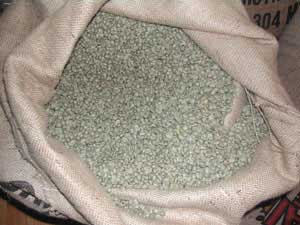 Unroasted coffee beans. Green coffee has gone through a multitude of processes from the time the coffee cherries are harvested to when the raw, dried, and dehusked "coffee beans" are packaged in burlap sacks ready for export. Also used to describe insufficiently roasted coffee.
|
Italian Roast
Dark roasted coffee with a very dark brown color and oily surface. There is disagreement regarding the labeling of very dark roast styles, with some asserting that an Italian roast is darker than a French roast and visa versa.
|
Medium Roast
Coffee beans roasted to a medium brown color, with a dry surface. A medium roast is slightly darker than an American Roast, the traditional norm in United States. However, the norm for specialty coffee today seems to center around Vienna, which is slightly into second crack with medium dark brown color and a dry to slightly oily surface.
|
Mocha Java
The oldest recorded coffee blend. Coffee was first grown in Ethiopia, but wholesale commercial export from the region began on the Arabian Peninsula through the port of Mocha. The Dutch later began cultivated and exported coffee from the Island of Java. Once blended it was discovered that the Mocha and Java coffees complimented each other for a more balanced cup.
|
New Crop
Recently harvested coffee. Coffee harvested in October 2007, for example, would be identified as 2007/2008 crop and would be considered current crop until October 2008. Coffee from a previous harvest year is referred to as old crop, or past crop.
|
Pyrolysis
Pyrolysis is a chemical change caused by heat. When roasting coffee, pyrolysis begins at about 370 degrees Fahrenheit, the temperature at which sugars in the coffee beans start caramelizing significantly. At about 400 degrees Fahrenheit, pyrolysis becomes significantly exothermic (the beans make their own heat). When roasting, the coffee beans should be exposed to temperatures significantly above 400F, otherwise the beans will roast too slowly and may not reach temperatures necessary for full flavor development. Coffees roasted at temperatures below pyrolysis will taste baked. After roasting, if the coffee beans are not cooled quickly, heat from pyrolysis will bake, or even burn, the coffee. A short period of water quenching (water mist) is the conventional method of halting pyrolysis in large batches.
|
Roast Master
Individual in charge of coffee selection, blending, and roasting operations.
|
Second Crack
The second of two distinctly different periods of cracking sounds during roasting when the coffee beans are giving off their own heat and expanding suddenly. The first crack begins at bean probe temperatures near 400 degrees Fahrenheit, making a sound similar to popcorn, and then diminishes, and sometimes stops momentarily, before start of the second crack. Second crack begins around 440 to 450 degrees Fahrenheit, as measured by roaster bean probe. The darkest of palatable roasts (Dark French) is attained at the peak of Second Crack. If the roast is allowed to continue to completion of second crack, the coffee will be burnt and may catch fire.
|
Single Origin
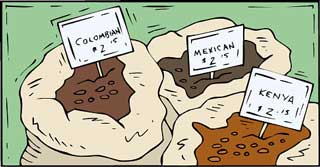 Unblended coffee from a single country, growing region, or plantation. Sometimes called straight coffee.
|
Spot Price
The current price of coffee to be delivered immediately, as compared to the contract price of coffee to be delivered at a future date. Spot prices are generally less than prices contracted for future delivery.
|
Varietal
Coffee made from a single cultivar of coffee tree. The coffee term "varietal" is also used to describe coffee from a single region or country.
|
Vienna Roast
A Vienna roast is the lightest of dark roasts and is complete after first crack, when the second crack has just started. Maximum aroma and flavor is usually achieved with a Vienna Roast, which has very little roasty flavor. Sometimes called "Full City" or "Full Flavor".
|




 An after dinner roast, or after dinner blend, is intended to compliment after dinner desserts. A typical after dinner coffee is dark roasted and has low acidity.
An after dinner roast, or after dinner blend, is intended to compliment after dinner desserts. A typical after dinner coffee is dark roasted and has low acidity.
 An air roaster, or fluid bed roaster, is a machine that uses fast streams of hot air to roast coffee beans. There are different types, or configurations, of air roasters, but all use hot air to convectively roast the beans and to help keep the beans moving. Most commercially available coffee is either air roasted or drum roasted.
An air roaster, or fluid bed roaster, is a machine that uses fast streams of hot air to roast coffee beans. There are different types, or configurations, of air roasters, but all use hot air to convectively roast the beans and to help keep the beans moving. Most commercially available coffee is either air roasted or drum roasted.
 Coffee beans created by adding two or more varieties together. Coffees are blended before, and sometimes after, roasting. There are many reasons for blending coffee. Coffees may be blended to add balance, to create flavors not found in single origin coffees, to add body, to add crema, or to maintain flavor consistency as new crops present changes in flavor.
Coffee beans created by adding two or more varieties together. Coffees are blended before, and sometimes after, roasting. There are many reasons for blending coffee. Coffees may be blended to add balance, to create flavors not found in single origin coffees, to add body, to add crema, or to maintain flavor consistency as new crops present changes in flavor.
 Chaff is the silver skin of the coffee bean released during roasting. While some coffees are put though an additional polishing step during processing to reduce the amount of attached silver skin, most unroasted coffee beans have a significant amount of the fine paper-like substance still attached which must be removed during roasting. As coffee beans are roasted, they expand to almost twice there original size. The dried out silver skin ruptures and is either burned away or carried away by the roast air. Most coffee roasters separate the chaff from the exhaust of their roasting machines using cyclone separators that collect the chaff in a metal bin.
Chaff is the silver skin of the coffee bean released during roasting. While some coffees are put though an additional polishing step during processing to reduce the amount of attached silver skin, most unroasted coffee beans have a significant amount of the fine paper-like substance still attached which must be removed during roasting. As coffee beans are roasted, they expand to almost twice there original size. The dried out silver skin ruptures and is either burned away or carried away by the roast air. Most coffee roasters separate the chaff from the exhaust of their roasting machines using cyclone separators that collect the chaff in a metal bin.
 Current crop (CC), meaning coffee harvested during the current crop year. For example, a coffee harvested in October 2007 would be identified as 2007/2008 crop and would be current crop until October 2008. Coffee from a previous harvest year is referred to as old crop, or past crop.
Current crop (CC), meaning coffee harvested during the current crop year. For example, a coffee harvested in October 2007 would be identified as 2007/2008 crop and would be current crop until October 2008. Coffee from a previous harvest year is referred to as old crop, or past crop.
 A cyclone separator is used to separate particulates, such as chaff, from roaster exhaust. The exhaust from cyclone separator is typically passed through a thermal oxidizer (incinerator) to burn the smoke. Roasters equipped with both a cyclone separator and thermal oxidizer emit a clean, smoke and particle free, exhaust.
A cyclone separator is used to separate particulates, such as chaff, from roaster exhaust. The exhaust from cyclone separator is typically passed through a thermal oxidizer (incinerator) to burn the smoke. Roasters equipped with both a cyclone separator and thermal oxidizer emit a clean, smoke and particle free, exhaust.
 A drum roaster roasts coffee in batches and uses a drum to hold the roasting coffee. As the drum spins, hot gasses transfer heat to the drum and the drum conductively heats the tumbling coffee beans. Some drum roasters have perforated drums that allow hot gasses to pass through the drum and convectively heat the roasting coffee. Most commercially available coffee is either air roasted or drum roasted.
A drum roaster roasts coffee in batches and uses a drum to hold the roasting coffee. As the drum spins, hot gasses transfer heat to the drum and the drum conductively heats the tumbling coffee beans. Some drum roasters have perforated drums that allow hot gasses to pass through the drum and convectively heat the roasting coffee. Most commercially available coffee is either air roasted or drum roasted.
 Unroasted coffee beans. Green coffee has gone through a multitude of processes from the time the coffee cherries are harvested to when the raw, dried, and dehusked "coffee beans" are packaged in burlap sacks ready for export. Also used to describe insufficiently roasted coffee.
Unroasted coffee beans. Green coffee has gone through a multitude of processes from the time the coffee cherries are harvested to when the raw, dried, and dehusked "coffee beans" are packaged in burlap sacks ready for export. Also used to describe insufficiently roasted coffee.
 Unblended coffee from a single country, growing region, or plantation. Sometimes called straight coffee.
Unblended coffee from a single country, growing region, or plantation. Sometimes called straight coffee.